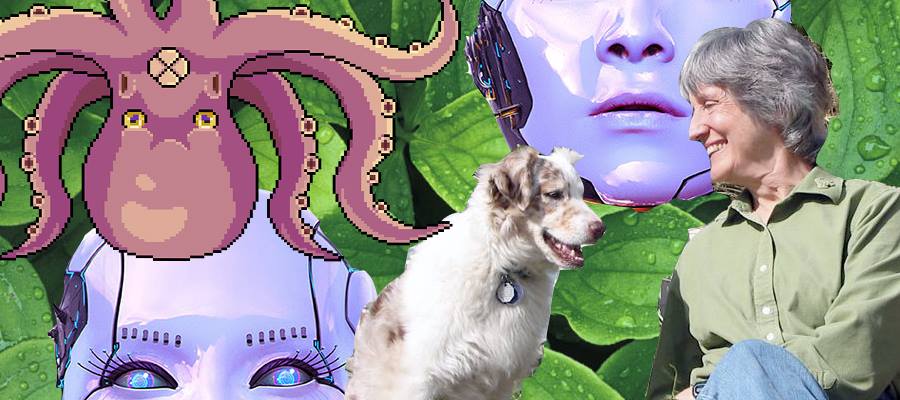On camera, Donna Haraway looks like the cool aunt everyone wishes they had. She is wearing a deep red shirt and has a silver bob, glasses, and a glint in her eyes while her dog, Cayenne Pepper, dozes off in the background. Belgian filmmaker Fabrizio Terranova spent weeks with her and Cayenne in southern California, capturing them in their natural habitat.
If all documentaries are fiction to some extent, the film titled Donna Haraway: Storytelling for Earthly Survival readily presents itself as a creative endeavour. Through fragmented interviews, archival materials, and animation sequences, it shows Donna Haraway narrating her family history and combing through three-decades worth of scholarship. On September 28, the film was screened at an event organized by Media@McGill, a cultural and media studies research group that offers grants for graduate students and organizes public events throughout the year.
Listening to Dr. Haraway talk is similar to watching Neil deGrasse Tyson’s Cosmos while high. Her playfulness and brilliant imagination allow her to spin a web of tales about her dog and childhood into theoretical models for surviving environmental devastation. You might expect her wit to be intimidating but she, like many of us, is also prone to rambling and has a quirky sense of humour, as most hippies do.
In 1984, Haraway published the text that canonized her in feminist scholarship, in which she famously declared, “I would rather be a cyborg than a goddess.” Her interest in cyborgs comes from her love for science fiction, specifically alternative worlds as imagined by women. In the 2016 film, Haraway reaffirms her desire to privilege “other women’s ideas, originality, and importance,” citing an indebtedness to Octavia Butler, Joanna Russ, and Ursula Le Guin.
Like a game of cat’s cradle, science fiction is built on giving and receiving patterns, making string figures of possible worlds and possible times, a form of storytelling that is itself a theoretical practice. Anticipating the future is a way of surviving the here and now – sometimes called anthropocene, the epoch in which human activity continues to significantly alter ecological conditions. The anthropocene is, as Haraway writes in her latest book, a time of “great mass death and extinction; of onrushing disasters,” a “muddle of messy living and dying.”
Storytelling was an essential part of Haraway’s childhood, “especially over dinner.” Her abundant use of metaphors in speech and writing affects how her arguments are read – like a story. A trained biologist, Haraway writes fluidly in an obscure tongue, delivering a weird, psychedelic blend of bacteria-laden scientific facts and poetic analogies about our relationship to earth. She has a way of describing the most minute natural processes that change profoundly how we envision our place in the world.
Formally, interview segments are interspersed among static long takes of scenes of nature, rejecting a coherent narrative structure. The nature shots, many taken in Haraway’s backyard, filled entirely with diegetic, or within-film sound, allow the audience to take in each shot in a suspended temporal realm. At one point, a voice-over sequence by Haraway’s partner compares versions of bird songs played at different speed, revealing a music that the human ear, in most circumstances, is unable to appreciate. In a parallel move, still shots of nature disrupt narrative flow to remind us to engage with what we often dismiss as background noise.
Perceptual tricks like these are played throughout the film, which recycles analogue footage from Haraway’s 1987 television appearance and shows her reacting to this footage in 2016. This doubling of figures is a recurring visual motif, with different shots of Haraway stitched together in a single frame, creating the illusion of spatial containment. These layering effects begin subtly and eventually escalate. In a particularly flamboyant moment, a majestic octopus emerges from Haraway’s desk while she sits, talking, and eventually fills up her room as if it were a cave in the deep sea.
Making kin and companions across species is an essential component of Haraway’s philosophy. For her and many other feminists, the cyborg imagery was useful for deconstructing mythic ideas of mind/body, human/machine, and human/monster binaries. As a materialist historian, Haraway remains dedicated to the very stuff that makes up this earth, speaking of cells and bacteria like a loving observer. The film ends with Haraway describing through voice-over a world where we live in organized communities with alternative family structures and collective child-rearing, hinting at more equitable futures. She too participates in the tradition of science fiction, of telling stories about surviving in turbulent, scary times.

